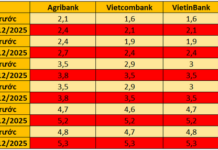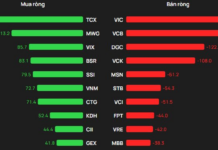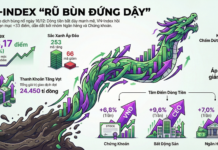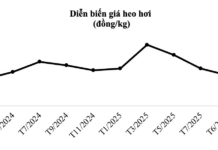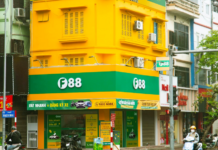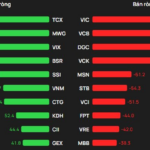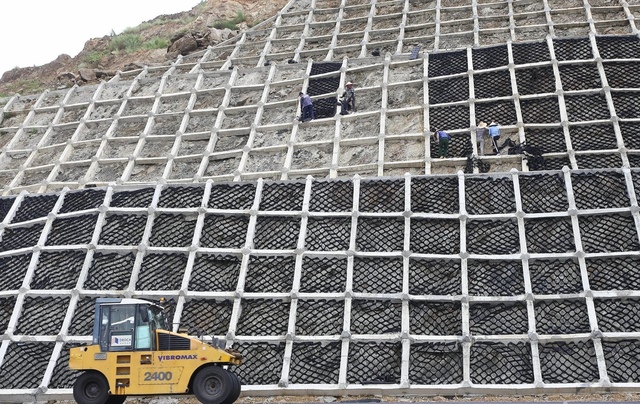
Construction companies have recognized that many revised rates in Circular 12 still do not accurately and adequately reflect the reality – Photo: GT newspaper |
On February 20, 2024, the Department of Construction Investment Management (Ministry of Transport) sent a document to contractors, consulting units on soliciting opinions on the rates for estimating the construction of works, including drafts of revised rates and supplements to Circular 12/2021/TT-BXD.
Construction companies have recognized that many revised rates mentioned in Circular 12 still do not accurately and adequately reflect the reality. The supplemental rates proposed by the management agency are much lower than the rates previously commented by the Institute of Construction Economics (Ministry of Construction). The biggest shortcomings in Circular 12 currently focus on 3 issues: labor, machinery, and depreciation of construction materials.
Kim Co Ring refers to “unit price”
Speaking to the Government Portal, Major General Nguyen Tuan Anh, Deputy Commander of the 12th Army Corps, Deputy General Director of Truong Son Construction Corporation – the unit currently implementing construction contracts for transportation works worth over VND 30,000 billion – said that the biggest difficulty for current transportation contractors is the unit price system, which sets rates significantly lower than the reality.
To illustrate this, Mr. Tuan Anh said: In the recent “price storm” of highway materials, the contract price for sand filling was about VND 153,000 per m3, but the actual price reached VND 254,000 per m3. A normal construction project, for the sand filling item alone, requires the use of up to 300,000 m3.
“By calculation, the contractor has to compensate for a loss of approximately VND 30 billion. As for the labor cost, the investor forced us to comply with the schedule, requesting the contractor to work “3 shifts, 4 groups”, but there is no hourly pay rate, salary rate specified, so the contractor does not know where to secure the additional funds.
Estimates of government-funded packages for construction according to unit prices and rates like above, make it difficult for contractors to make profits, and even incur losses when facing significant price fluctuations such as the period of 2020 – 2022″, Major General Nguyen Tuan Anh said.
From the above reality, the representative of Truong Son Construction Corporation believes: “Removing the Kim Co Ring called unit price, rate is a very urgent issue because, otherwise, Vietnamese enterprises will find it very difficult to accumulate resources to grow and reach international level”.
Similarly, Mr. Vu Duc Nhan, Deputy General Director of Phuong Thanh Company, also shared the difficulties when the average progress of a highway project is shortened to only 2 years instead of the usual 4-5 years, requiring contractors to maintain a large amount of labor.
“In the North – South highway project phase 1, the actual construction time each year is only about 5-6 months, the rest is rainy weather all year round that cannot be deployed for construction. Meanwhile, the contractor still maintains full equipment and human resources on site to take advantage of favorable construction conditions. Such construction within a very short time period forces the contractor to mobilize a large amount of machinery, equipment, and human resources to compensate for the schedule. Although it is a disadvantage, the labor costs increase, the contractor is not considered”, Mr. Nhan said.
Agreeing with the above views, Mr. Nguyen Hong Quang, Deputy Chairman of Dinh An Group, added that in the current unit price, there are 2 parts that need consideration: the direct unit price and the material depreciation coefficient is too low. Even “completed projects may have to sell specialized equipment immediately, because the more they keep, the more loss they incur”.
Previously, in the recommendation document sent by 12 contractors to the relevant agencies when implementing the North – South highway project phase 1, it was clearly stated that the average direct unit price was missing by half. For example, the unit price for the implementation of 1 m3 of concrete is only from VND 600,000 – VND 650,000, but the actual price is from VND 1.2-1.5 million.
Regarding the depreciation of materials and machinery, the fixed unit price has been established for too long, without the introduction of special equipment for implementation, the contractor must invest in equipment to ensure the progress and quality.
For example, buying a Nikko mixing plant made in Japan costs about VND 30-40 billion, from South Korea about VND 20 billion, a pile driver system about VND 20 billion, a paver machine about VND 10 billion… With continuous depreciation calculated in the fixed machine unit price, dispersed quantity, after the construction is completed, the contractor must sell the equipment immediately because the longer they keep it, the more loss they incur.

The actual labor price issued in Circular 12 is lower than the price of ordinary labor in the market – Photo illustration
|
Creating realistic rates is necessary
Major General Nguyen Tuan Anh suggested: There needs to be a code of rates that is described, defined, with specific application conditions, clear, to avoid the situation where one item applies multiple rates. In addition, when establishing the rate, the state management agencies should conduct on-site verification and comparison with the reality.
In addition to the labor price applied according to rates issued by localities in the project area, construction companies also indicated: The labor price applicable at the minimum level is around VND 200,000-300,000 per day but the actual market price for ordinary unskilled labor is already VND 400-500,000 per day, not to mention holidays and days off which need to be multiplied by 200-300%.
Regarding the shortcomings in applying the cost index for materials, for projects implemented in localities where the required materials are either not available or available but do not meet the required standards, the contractor is forced to purchase materials in other localities at higher prices than in the project area, and the transportation costs also increase.
Mr. Nguyễn Hồng Quang also shared that businesses hope that the management agencies will soon issue new rates that are more suitable with the reality so that businesses no longer have the situation of “finishing a project and having to sell machinery to reduce losses”.
Urgently resolving difficulties related to transportation project rates, prices, building materials
On January 9, 2024, Prime Minister Pham Minh Chinh signed Directive No. 02/CD-TTg, sending it to the Ministers of Construction, Transport, Natural Resources and Environment; Chairmen of Provincial People’s Committees, and centrally-run cities to direct the focus on removing difficulties and obstacles related to rates, prices for construction; exploitation and supply of building materials for key transportation projects and national important projects.
The Directive clearly states that in order to promote the implementation progress of construction investment projects, especially transportation projects that contribute to the achievement of socio-economic development goals, the Prime Minister requires:
The Minister of Construction to direct related units: To study, review, amend, supplement the legal documents related to the management of construction investment costs to ensure their appropriateness and feasibility in implementation, report to the Prime Minister on the situation of implementation in March 2024.
Urgently review, adjust, and supplement the rates that have been issued by the Ministry of Construction within its authority but are still not appropriate or missing, and report to the Prime Minister the results of implementation in April 2024.
Proactively coordinate with specialized construction project management agencies, localities to organize the construction of special estimate rates for each specialized industry, locality, related to the construction technology, construction conditions, new building materials that are not yet included in the current rate system.
Actively instruct and urge localities to announce construction prices, building material prices (quarterly or earlier if necessary), construction labor costs (annually or earlier if necessary) in a timely, sufficient, and legal manner; inspect the implementation situation in localities that have key transportation projects.
The Prime Minister also requires the Minister of Transport to direct, identify the list, and plan the review of specialized construction estimate rates while organizing the construction of estimate rates under the jurisdiction of the Ministry of Transport to send the Ministry of Construction for opinions before issuing… Coordinate with the Ministry of Construction to review and improve construction estimate rates to ensure their suitability with the characteristics of the transportation industry.
Implement the above-mentioned instructions of the Prime Minister, on January 29, the two Ministries, including Construction and Transport, had a meeting to implement Directive No. 02. At this meeting, Mr. Nguyen The Minh, Deputy Director of the Department of Construction Investment Management (Ministry of Transport), also admitted that: Currently, the rates for transportation works issued by the Ministry of Construction in Circular 12 are still missing many rates for use, many rates have been issued but are not suitable. Especially for public investment projects that are still subject to supervision by post-inspection agencies.
In practice, post-inspection agencies all identify rates, material prices, labor costs, and machinery for construction according to the announcement of the authorized agencies to determine the revised estimate and serve as a basis for requesting deduction of payments.
Therefore, despite having regulations, investors still use material prices, labor costs, machinery for construction according to the announced prices of localities to approve the project’s construction estimates, which are often not suitable for the market price level and specific conditions of the project.
Regarding labor prices, the Department of Construction Investment Management of the Ministry of Transport also noted: According to the regulations, the labor price announced by localities currently applies the minimum regional wage level and refers to the reference price issued by the Ministry of Construction. However, in reality, the issued labor prices are lower than the common labor prices in the labor market.
Regarding cost management, material prices according to current regulations are determined based on the price announcement of the locality or the quotation of the supplier. However, for projects applying specific mechanisms in mineral exploitation as conventional construction materials, the determination of the exploitation price at the mine depends on the agreed price with the owner of the land area (transferred price, land use rights lease, financial support on the land surface coloring). The agreed prices of the owners have not been unified, there is a large difference, and there is no specific guidance, making it difficult to manage costs for investors.
“The Department of Construction Investment Management has reviewed, summarized, and sent documents to the Economic Department (Ministry of Construction), including 547 construction estimate code that need to be newly established and adjusted before being issued,” Mr. Nguyen The Minh said.
Phan Trang







